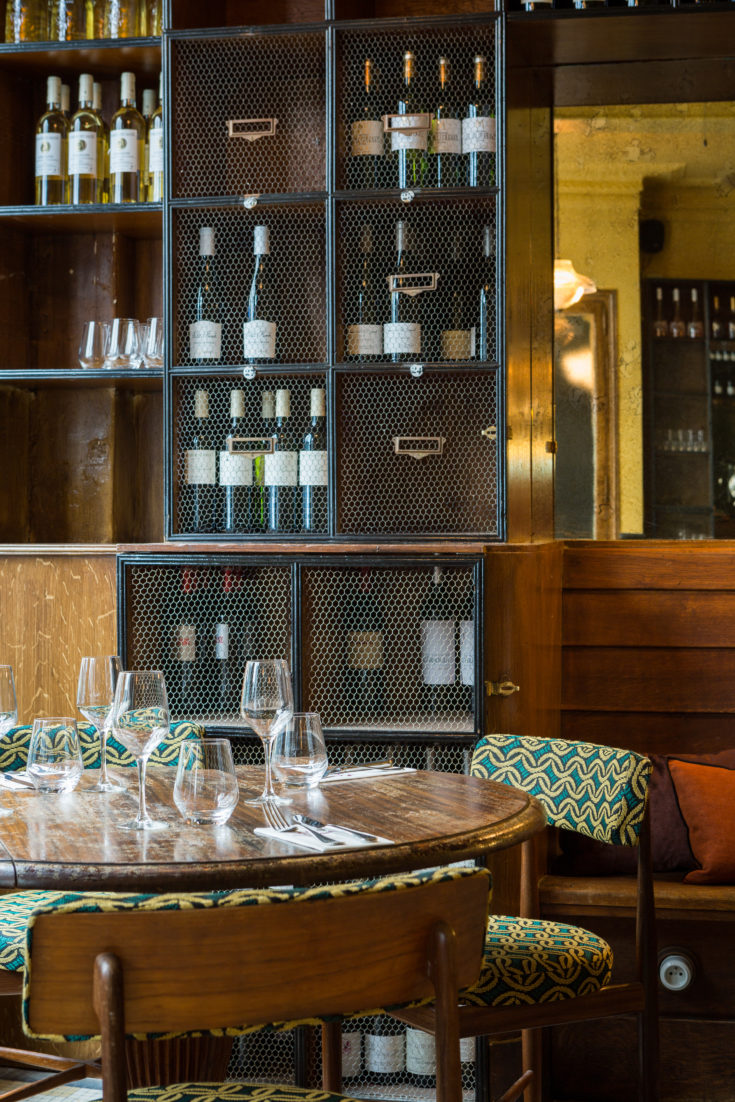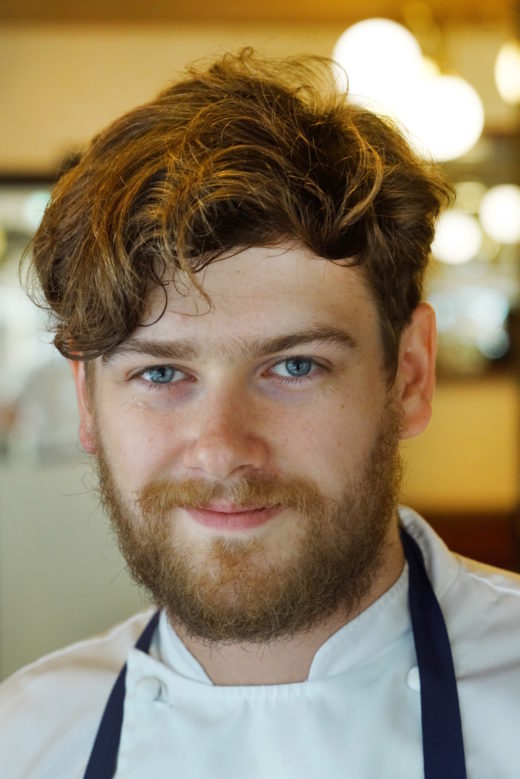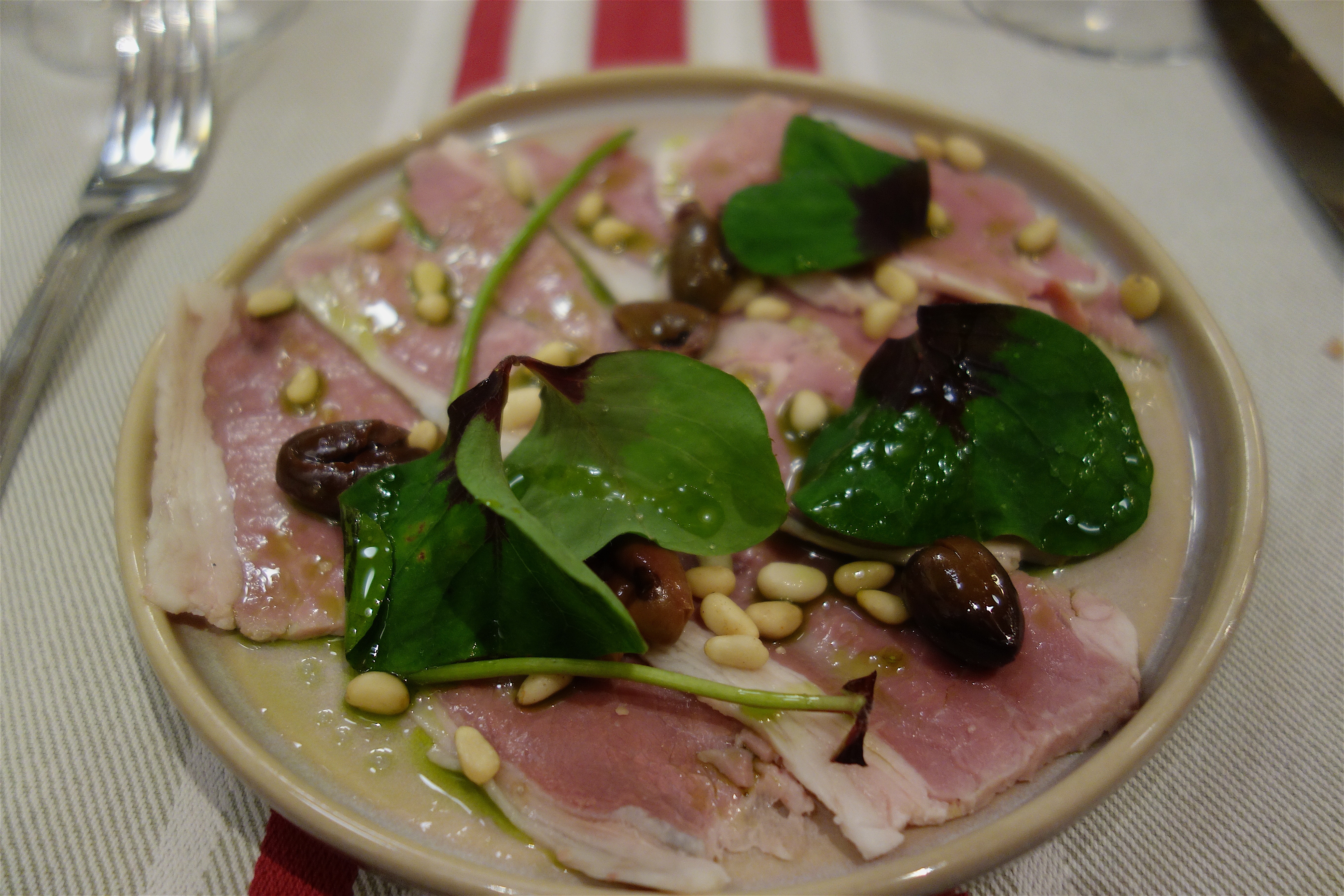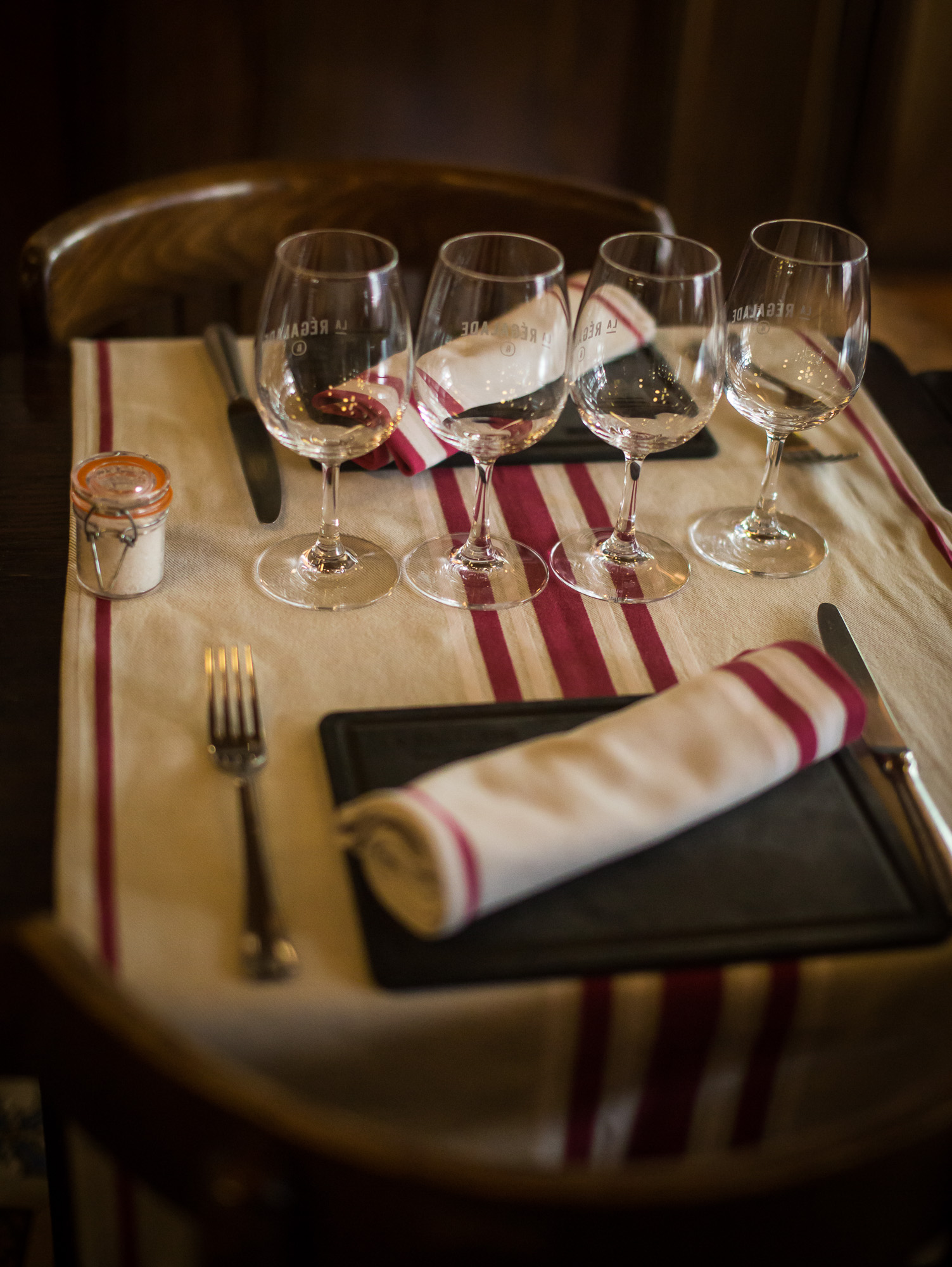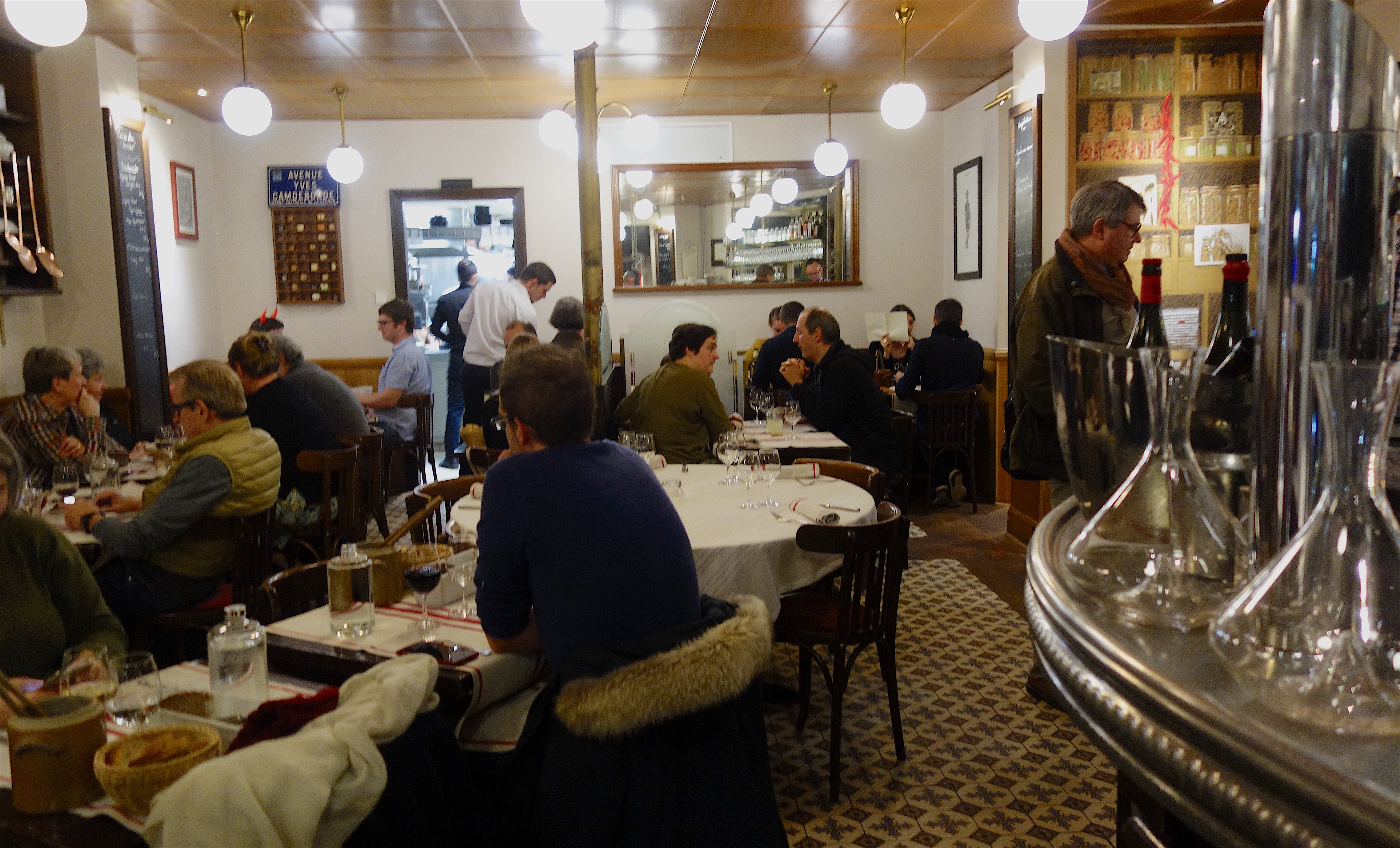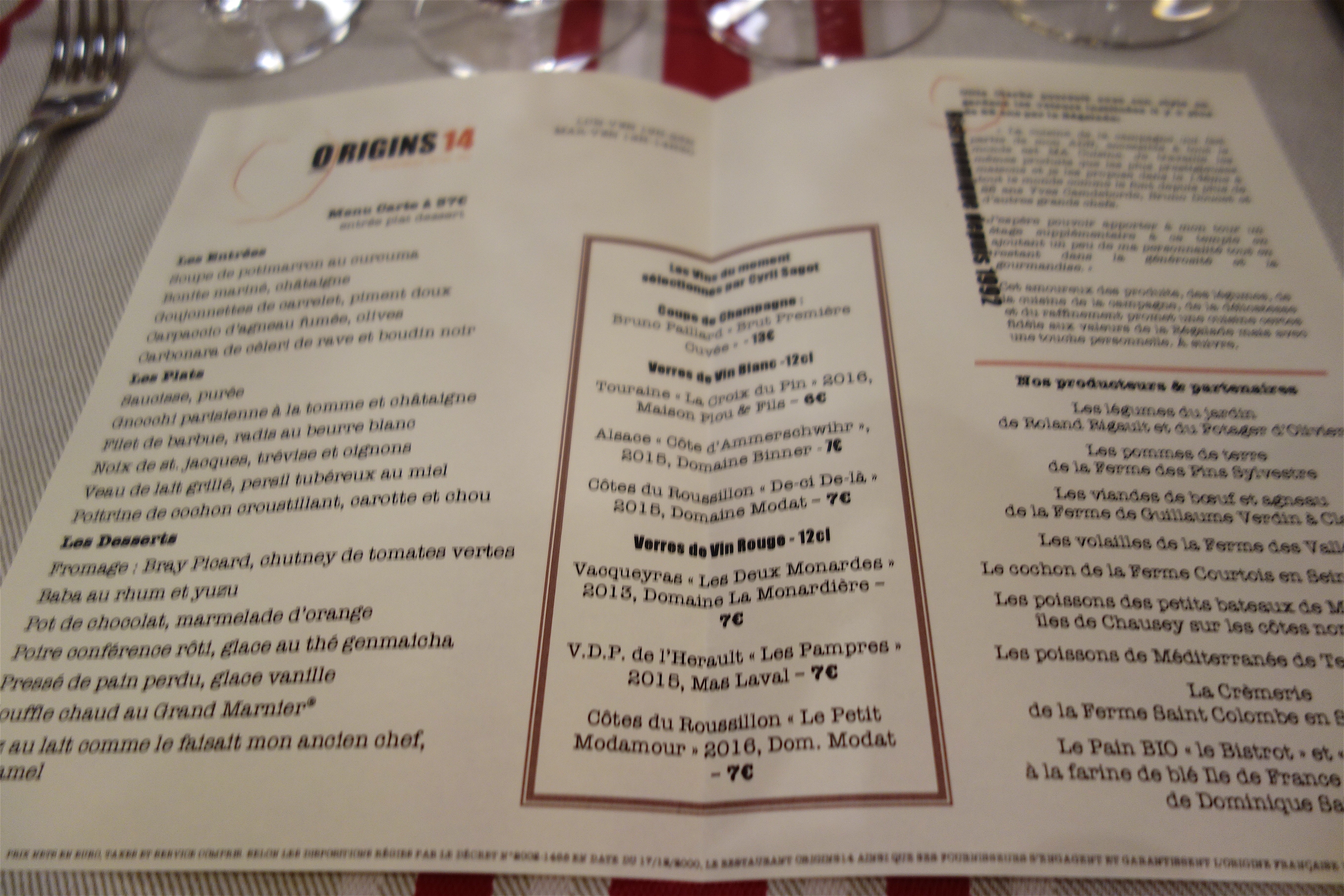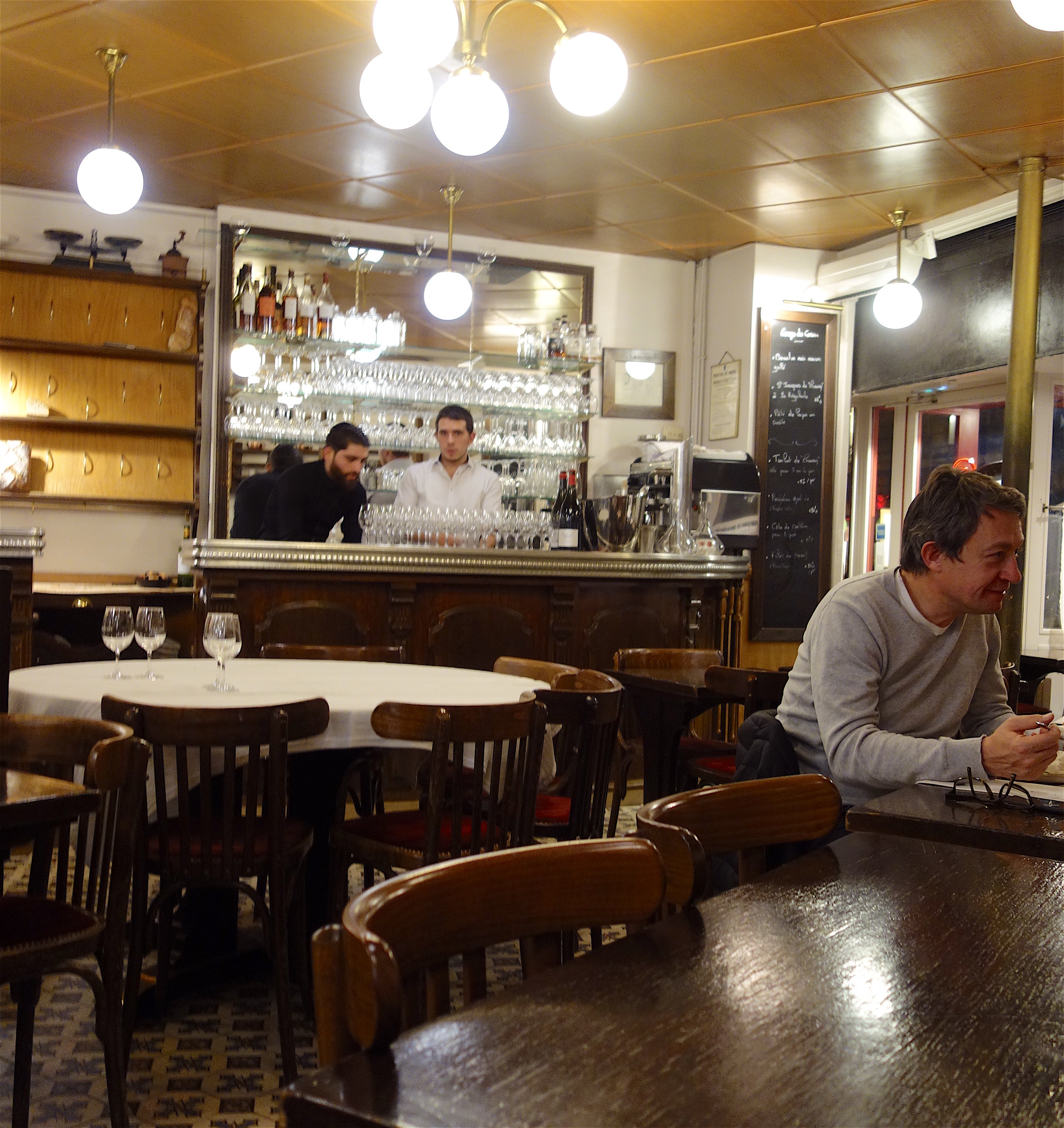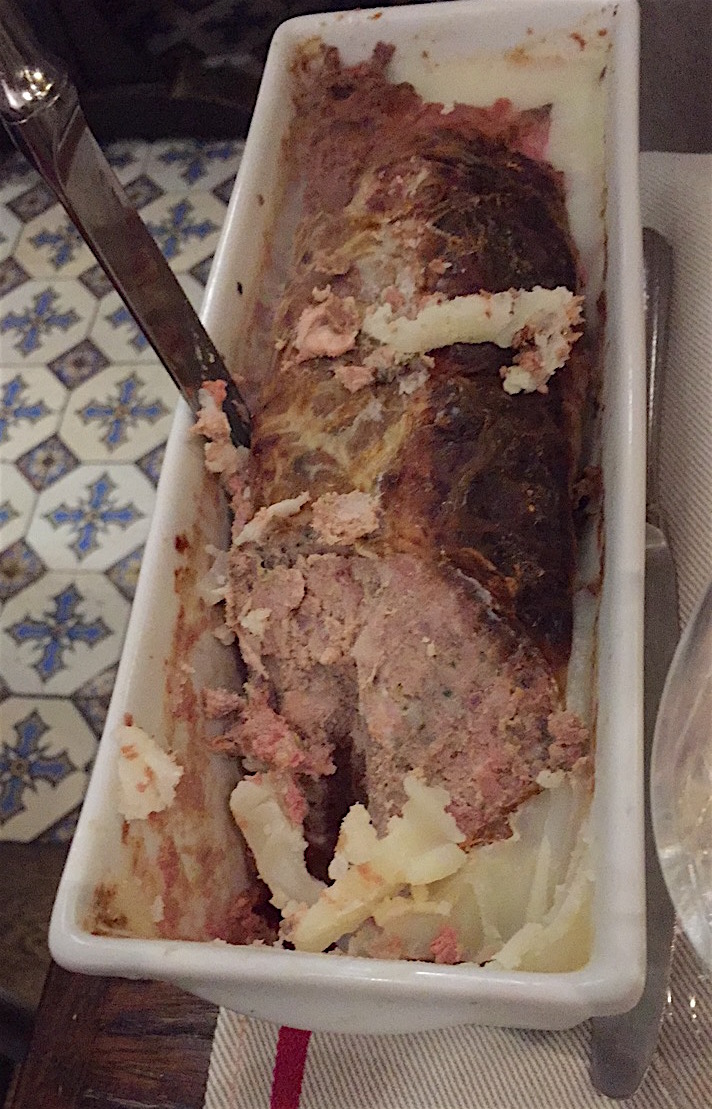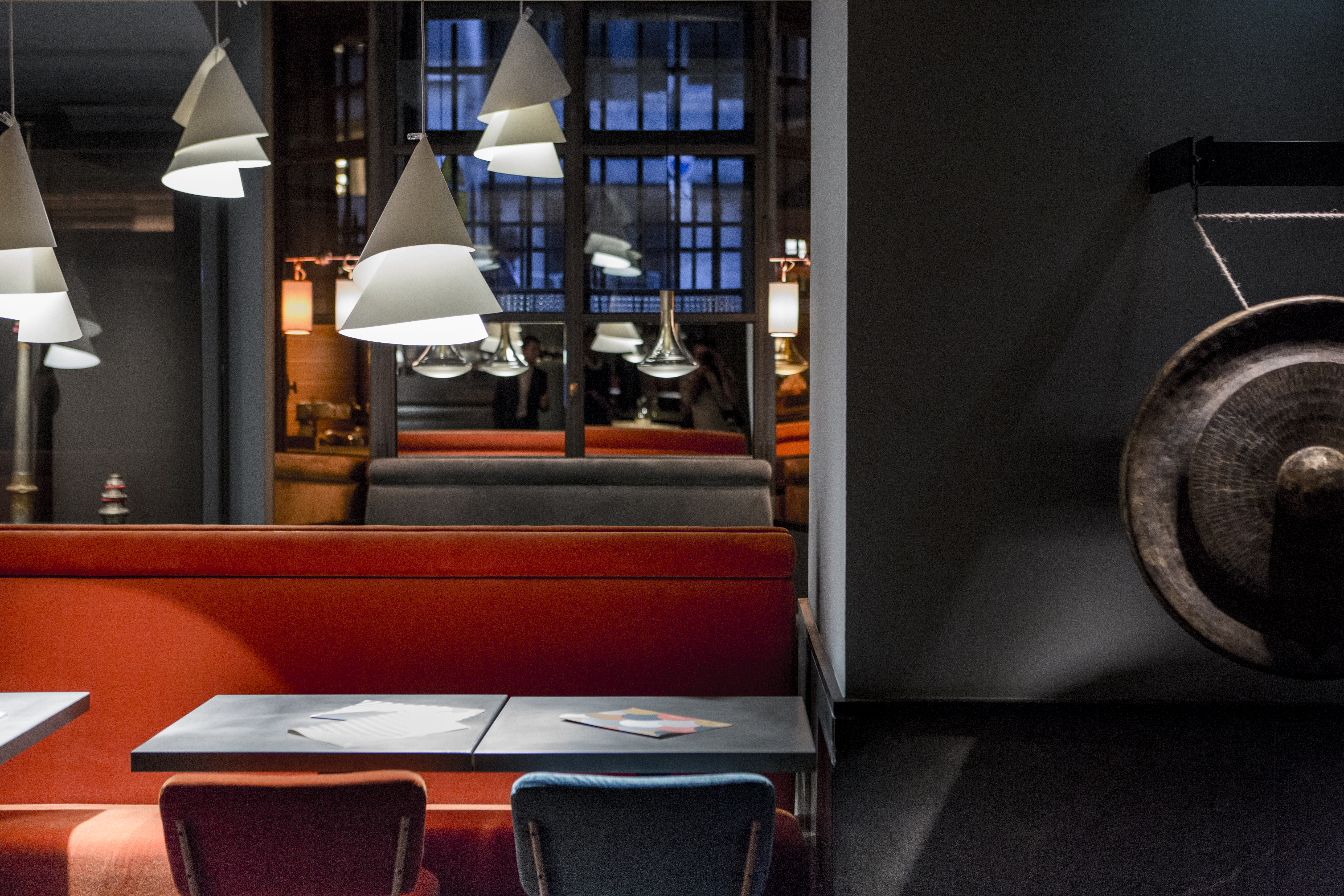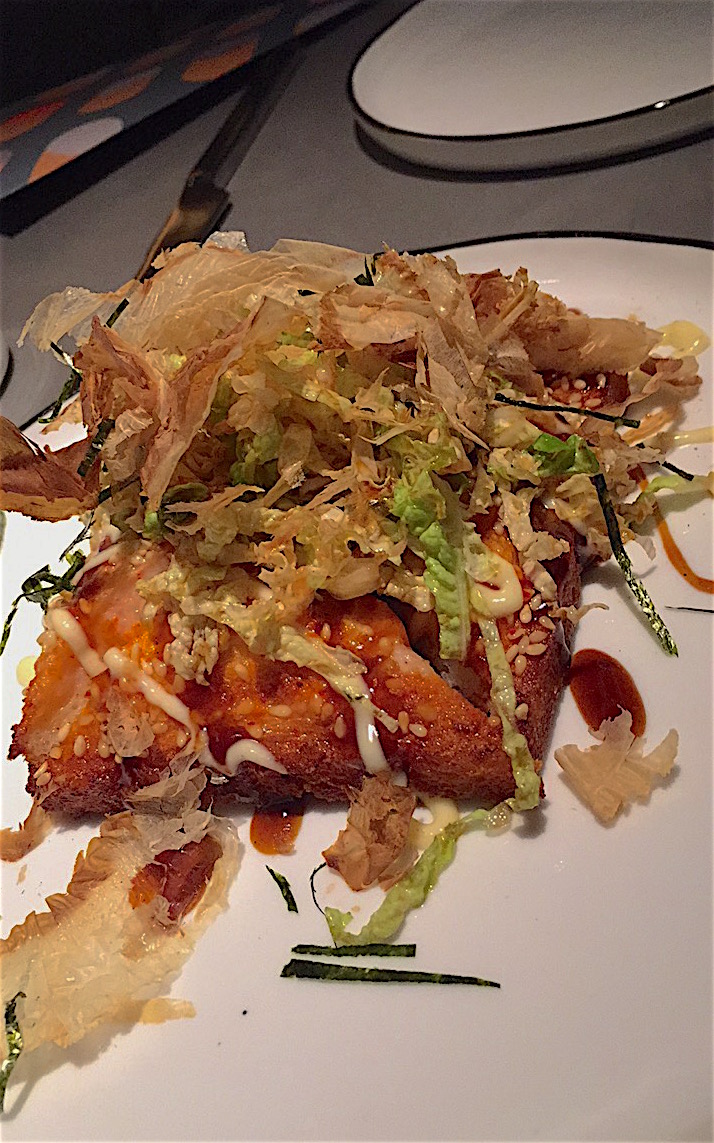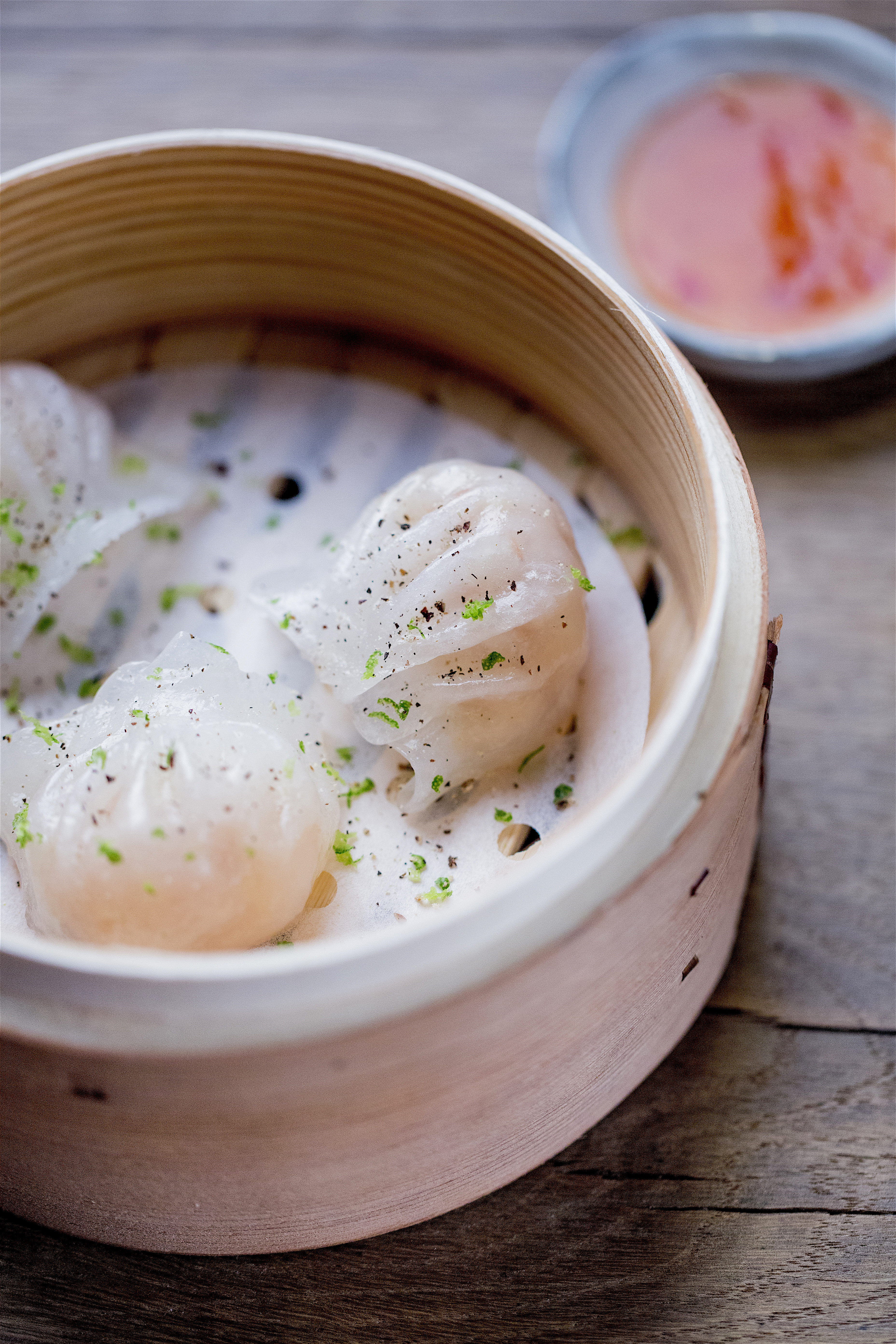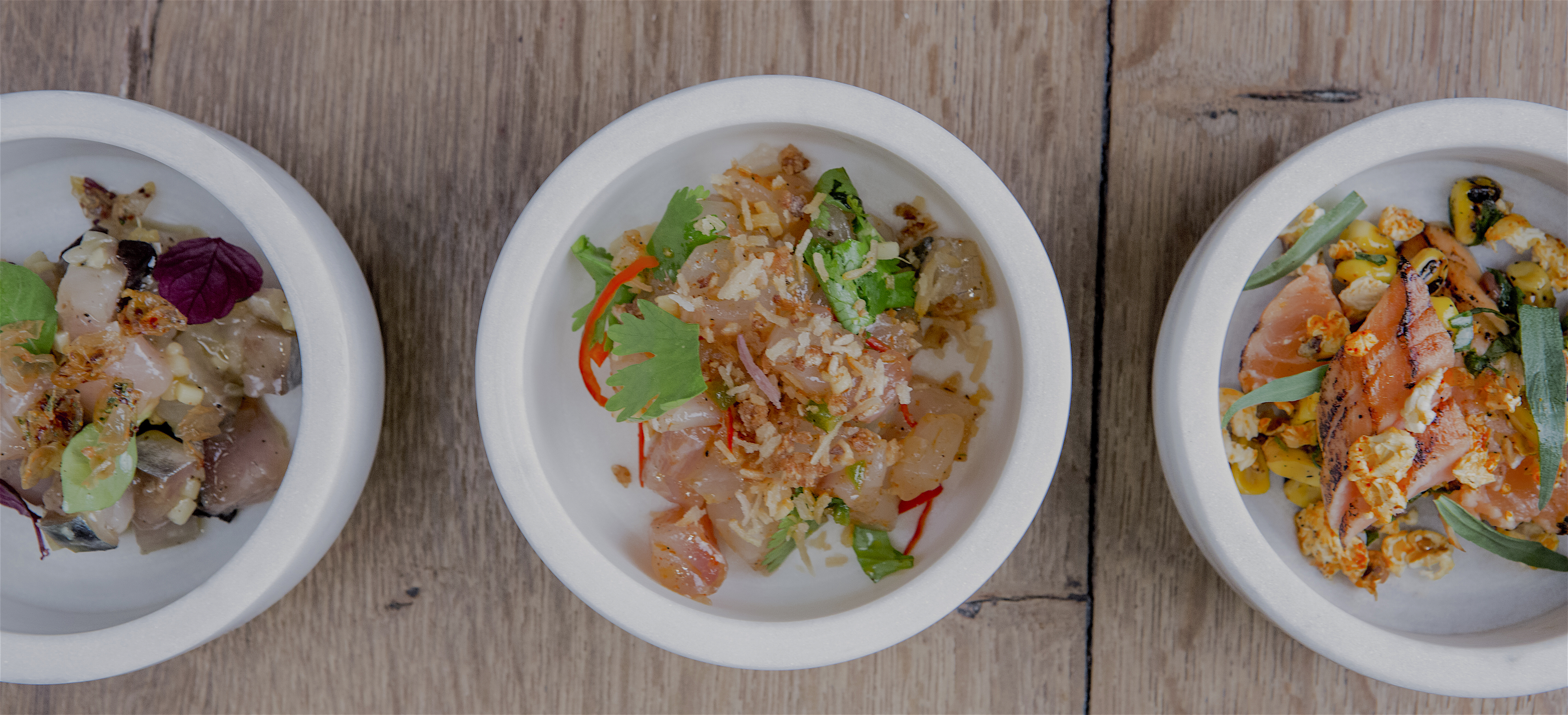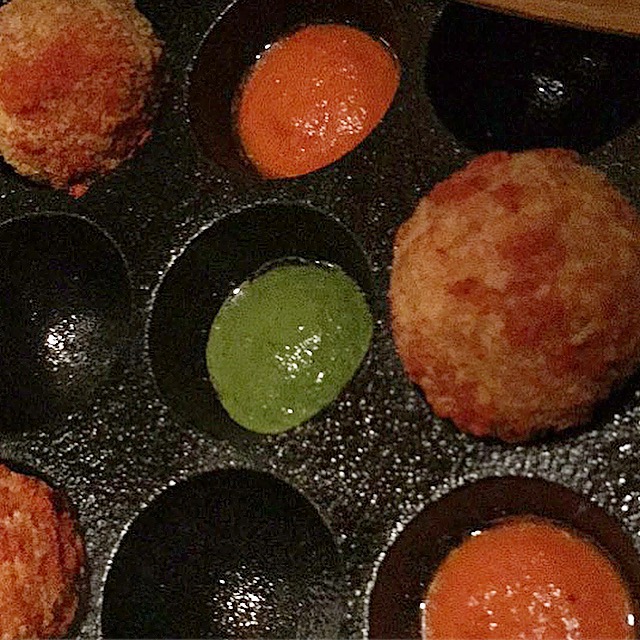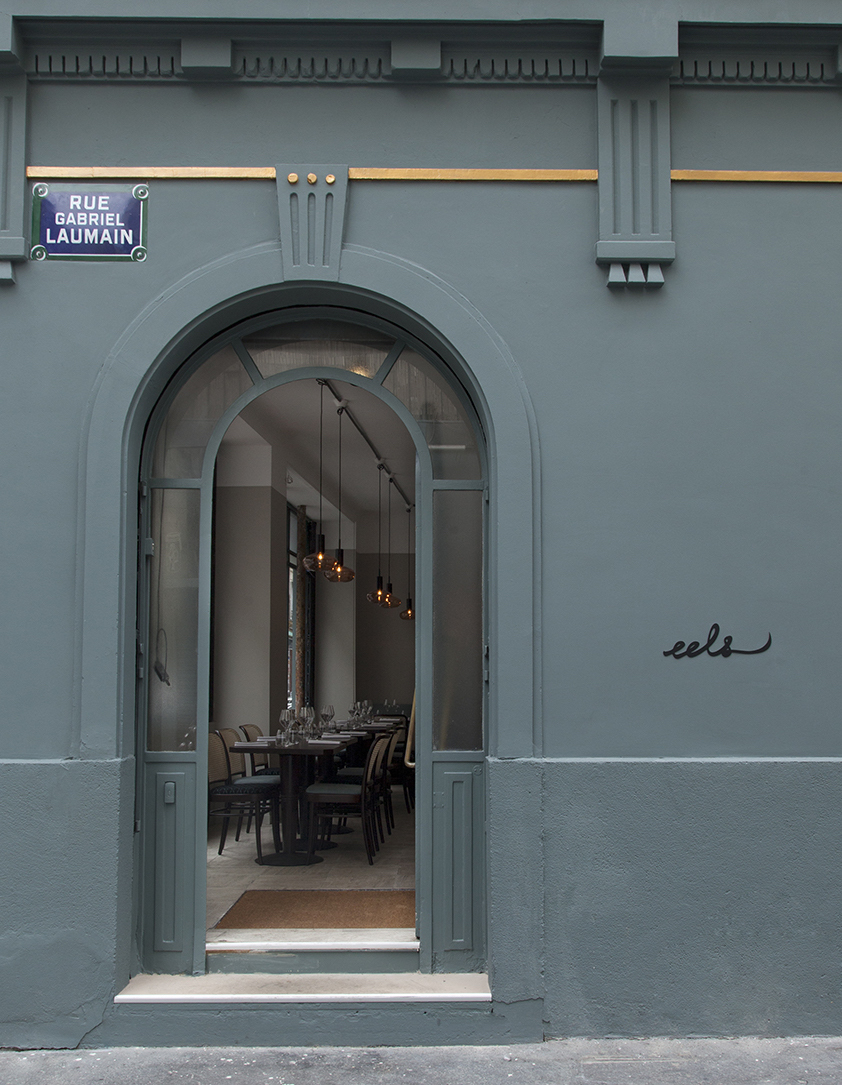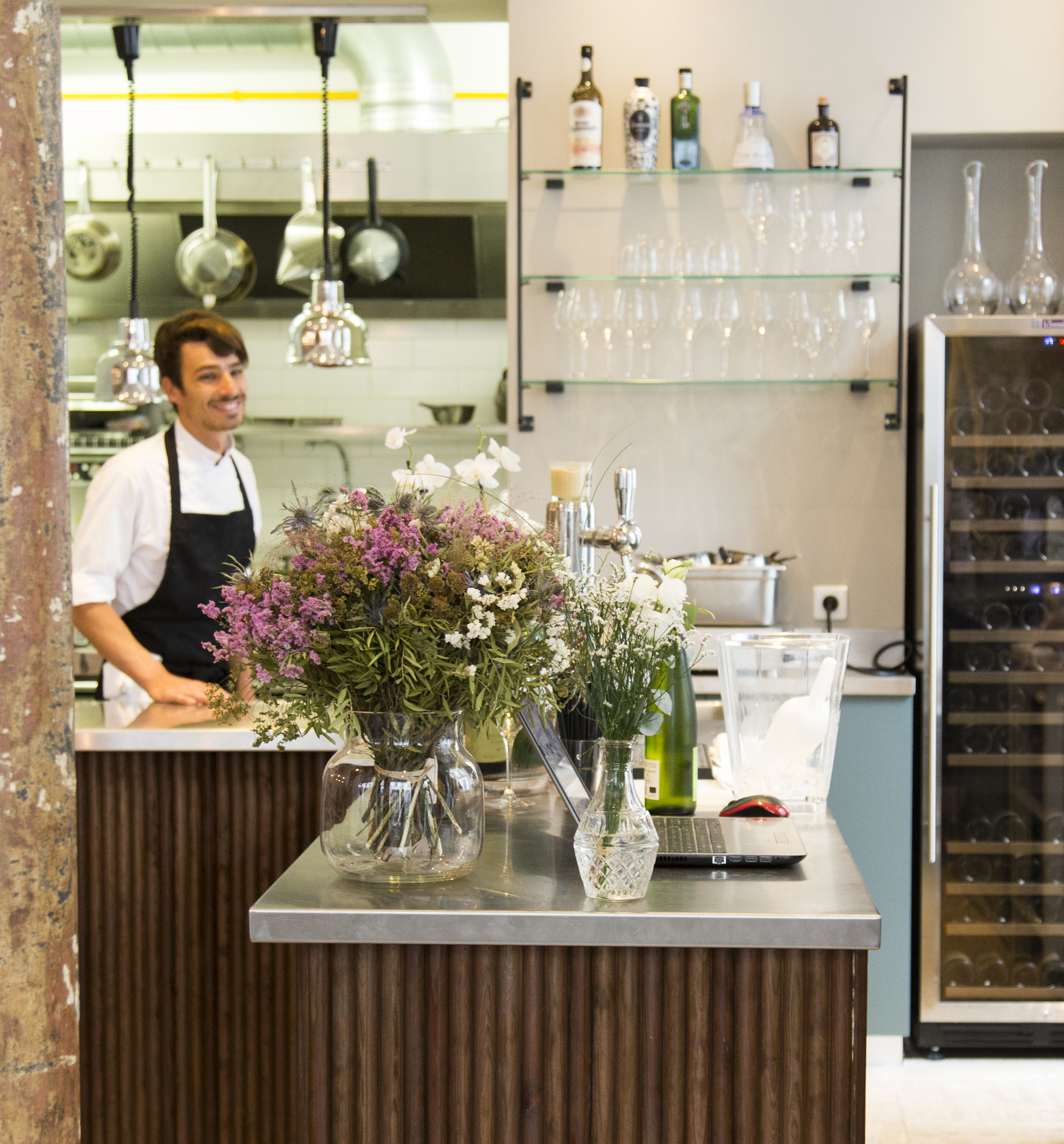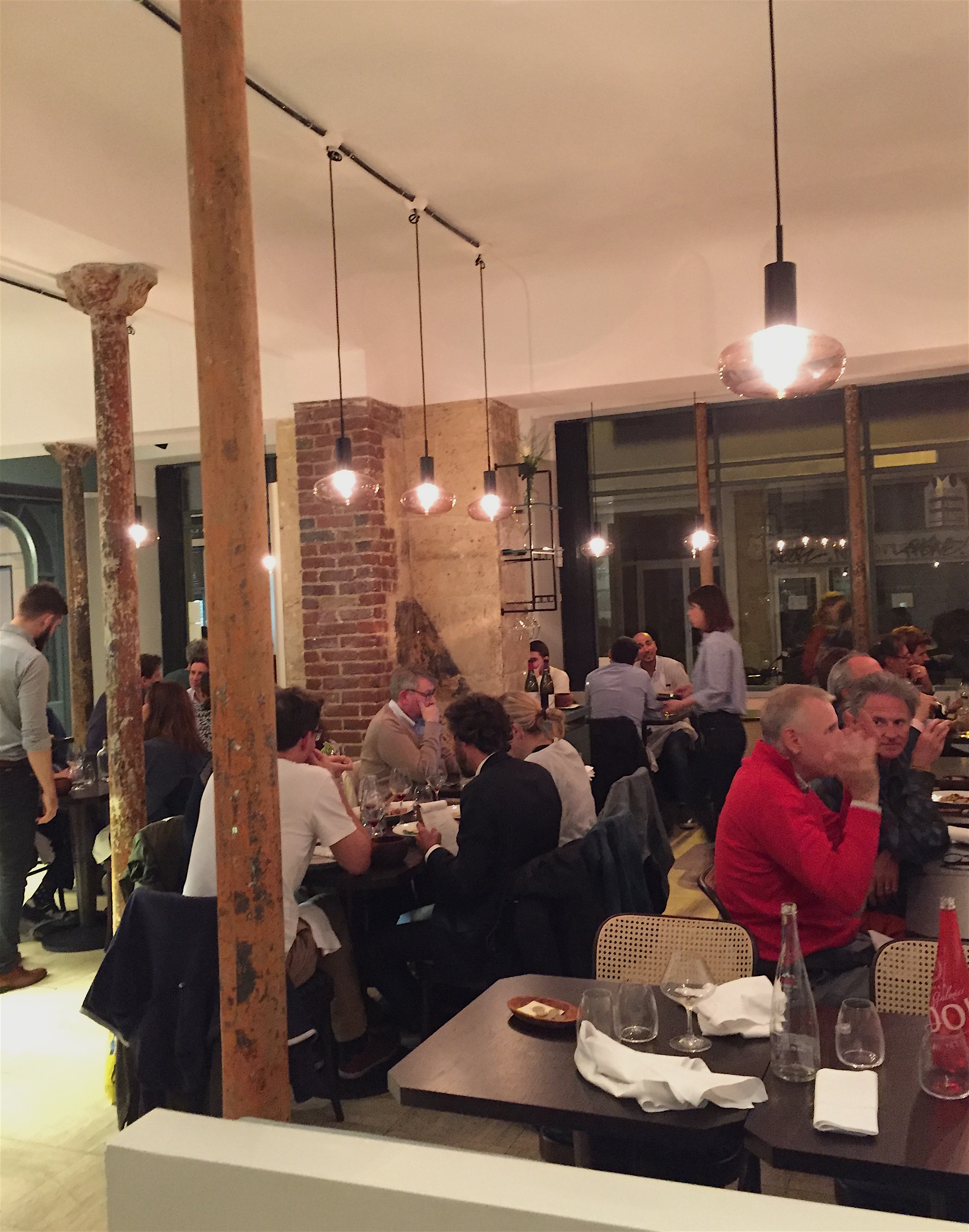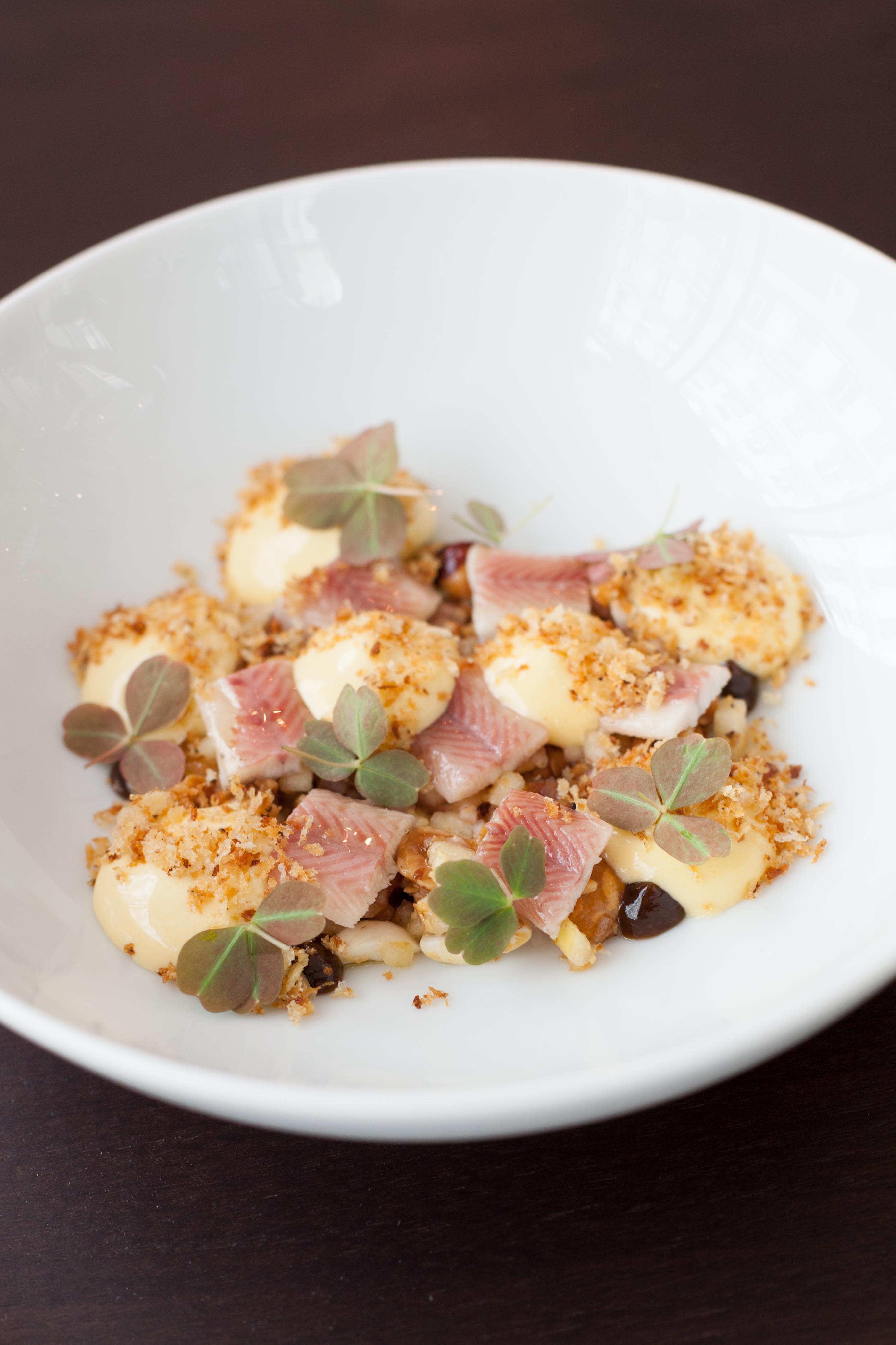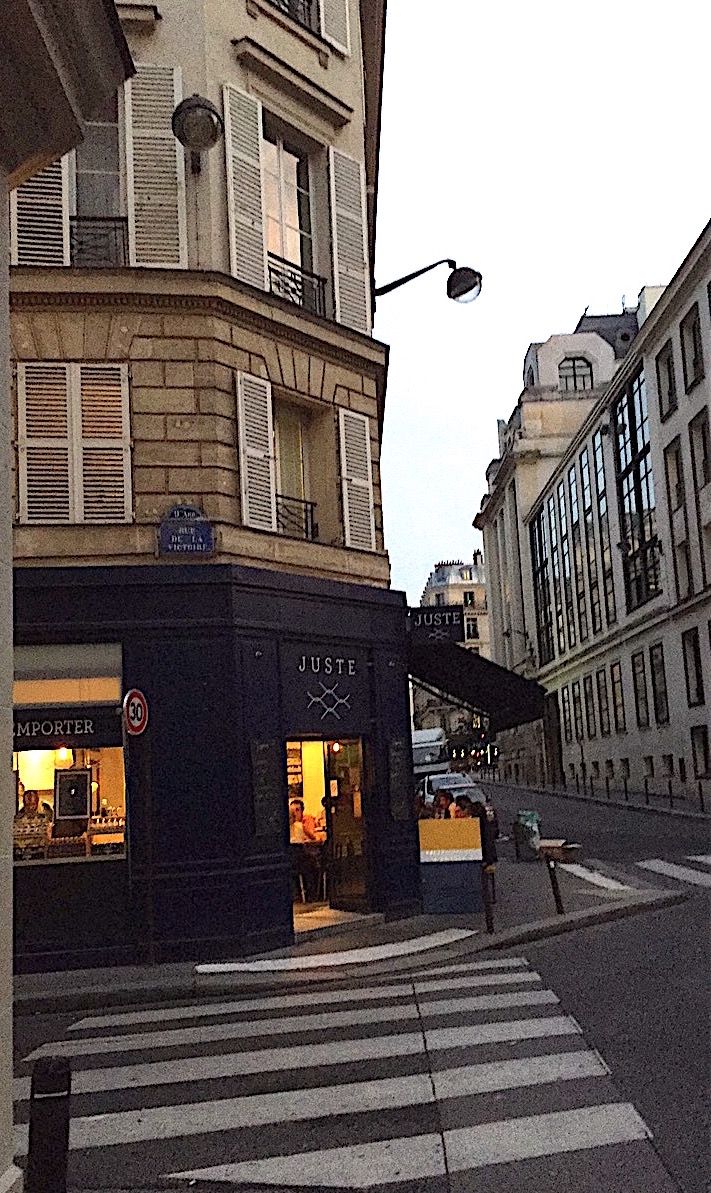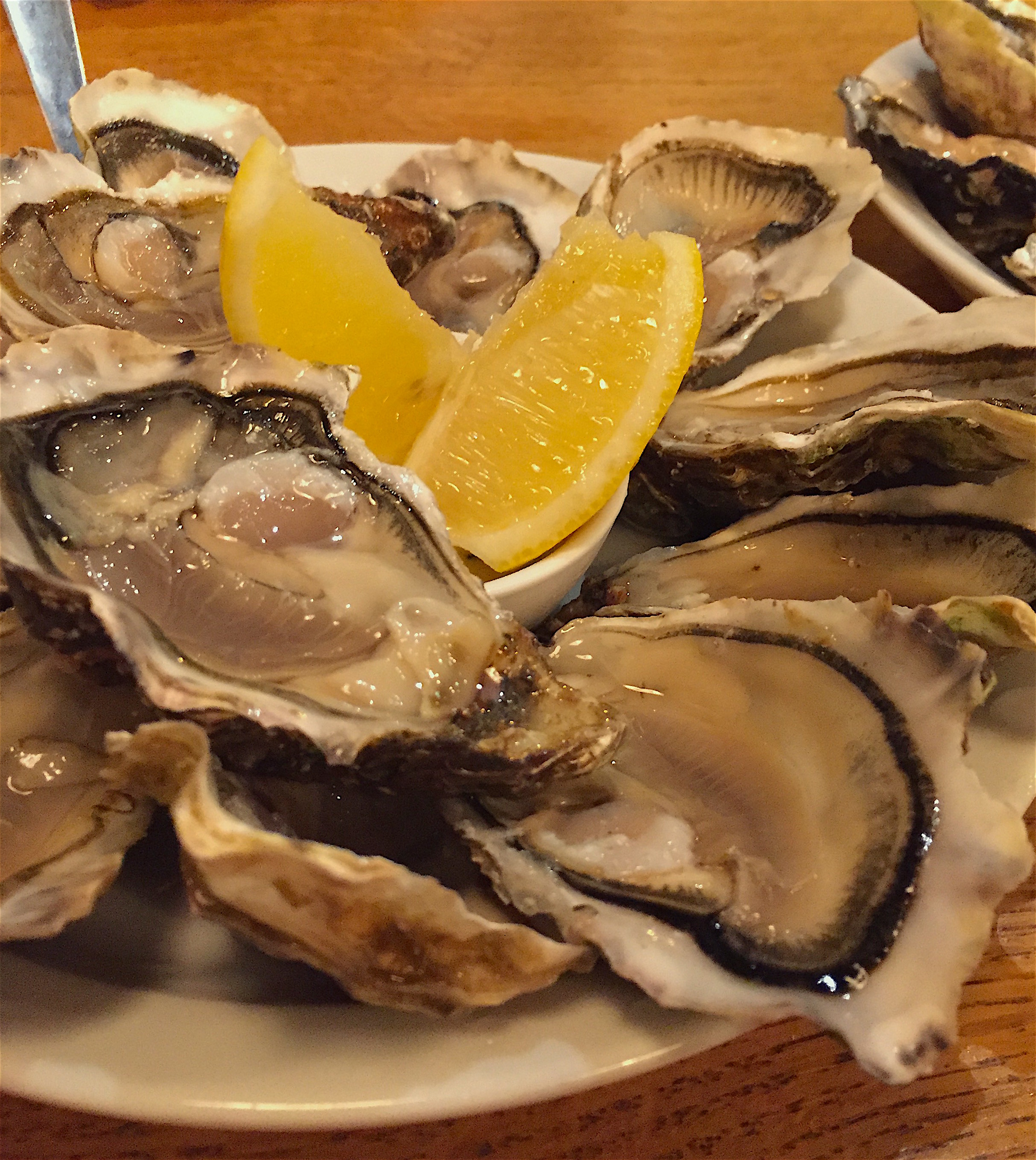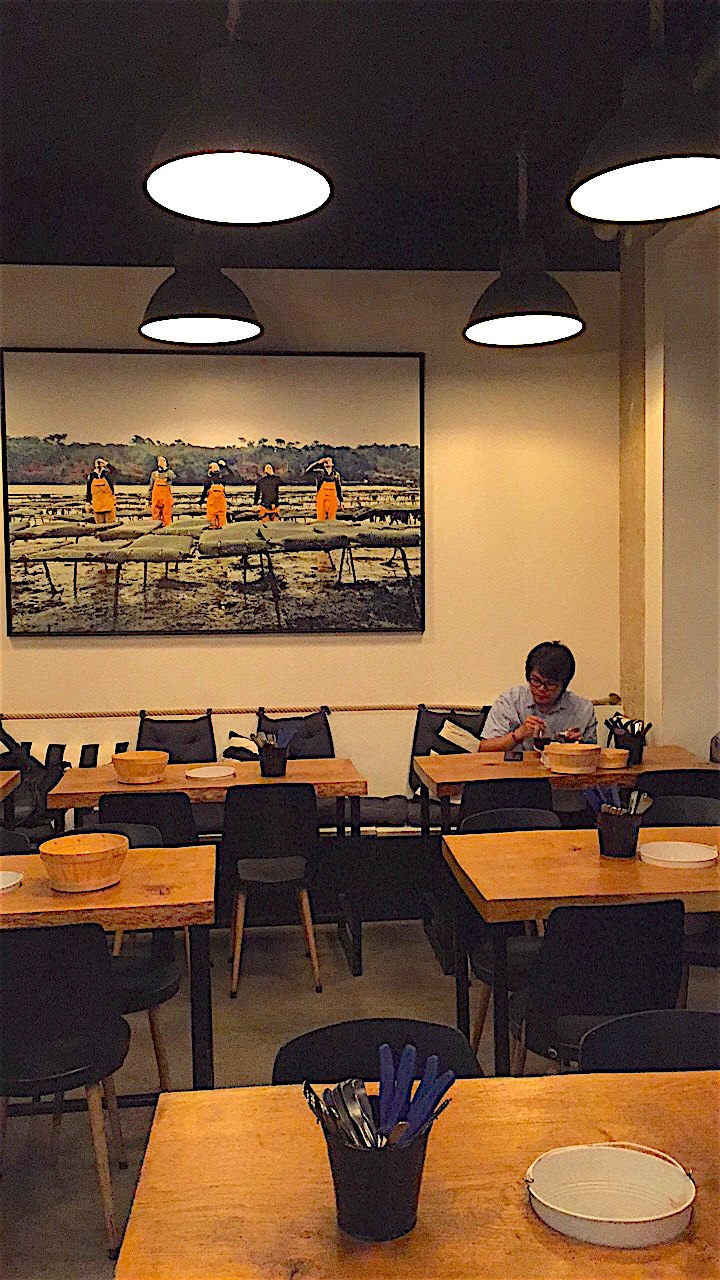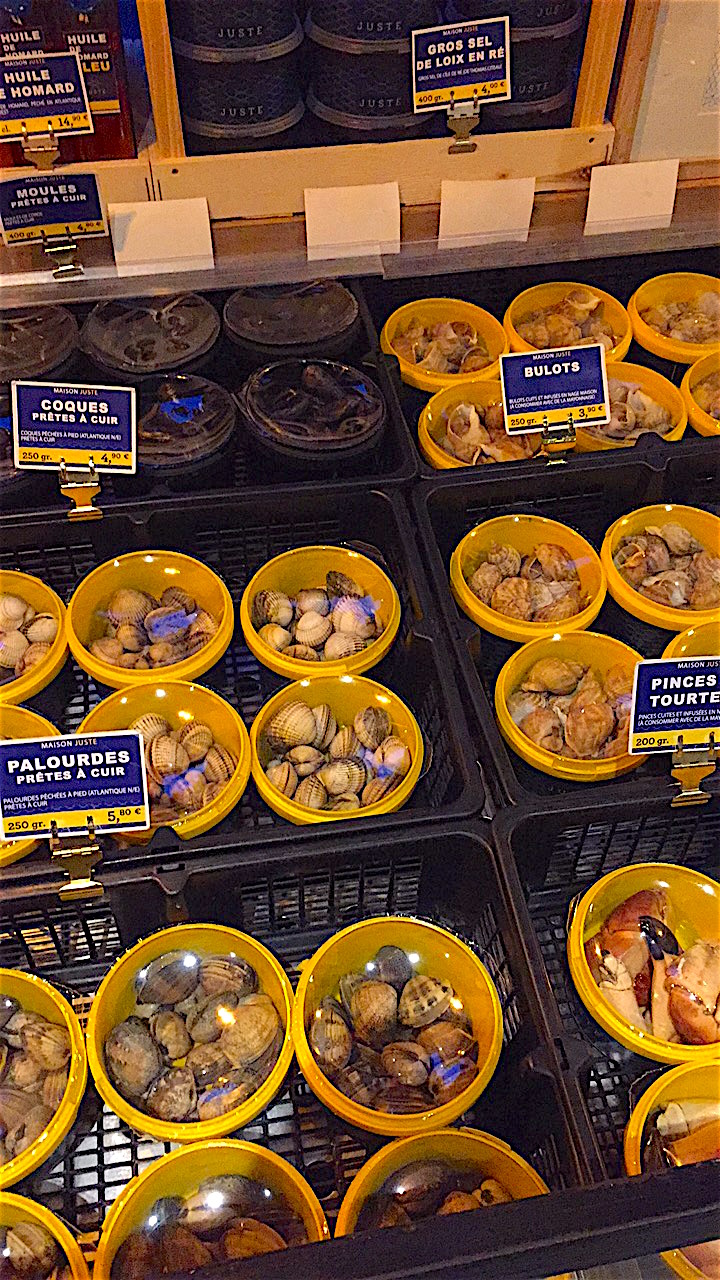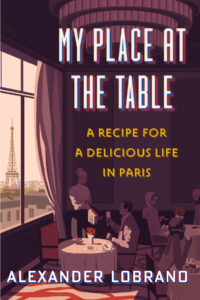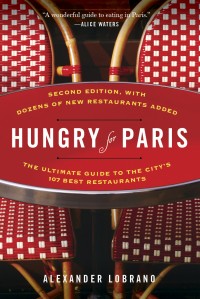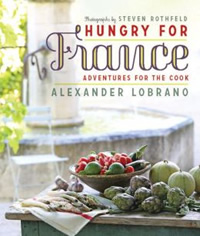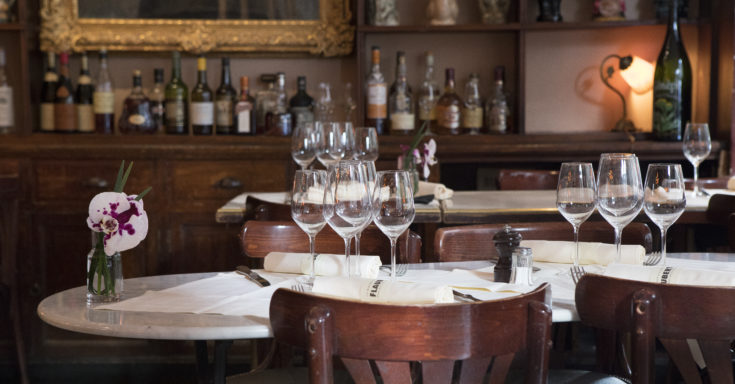
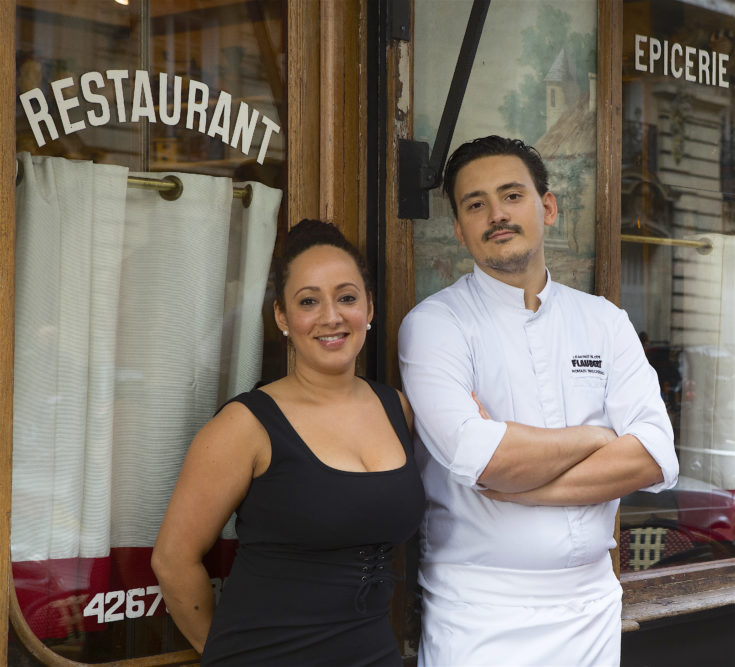
Laetitia and chef Romain Brechignac @Lisa Klein Michel
A really excellent recent meal at Le Flaubert, which was originally called Le Bistrot d’a Cote when two-star Michelin chef Michel Rostang first opened it thirty years ago, got me to thinking about the impact of the internet on restaurant writing. To wit, the only reason I had this fine feed at a restaurant I’d once loved but hadn’t been to in over ten years is that some visiting friends from South Africa had been advised to eat there by a good hotel concierge. Otherwise, I am usually so caught up in the cycle of the new, new, new–Hello, SEO (search engine optimisation) that I very rarely find the time to go back to places I’ve enjoyed to see how they might be evolving, holding up, changing.
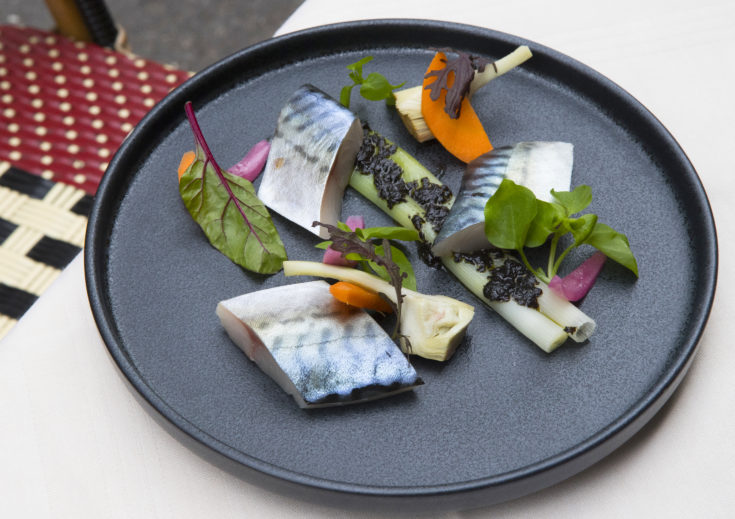
What this does, in effect, is penalize the careers of established chefs and well-run restaurants, since after the initial blaze of publicity when they open, how do they remain sought-after, talked about, and most of all profitable when the whole dining-out gig is so gamed towards the new? To be sure, a great chef can win a solid following of regulars who fill his or her dining room day in and day out, but the ferocity of the new remains hard to overcome, since it’s become a given that novelty is the best driver of cyber clicks, because–it is hoped–they will translate into on-line advertising, assumed to be the last bandage of ever more seriously ailing print publishing.
It’s not that the New hasn’t always driven media, but rather how fierce this has become as we read more and more online, with the websites’ infinite need for fresh content, than we do in print.
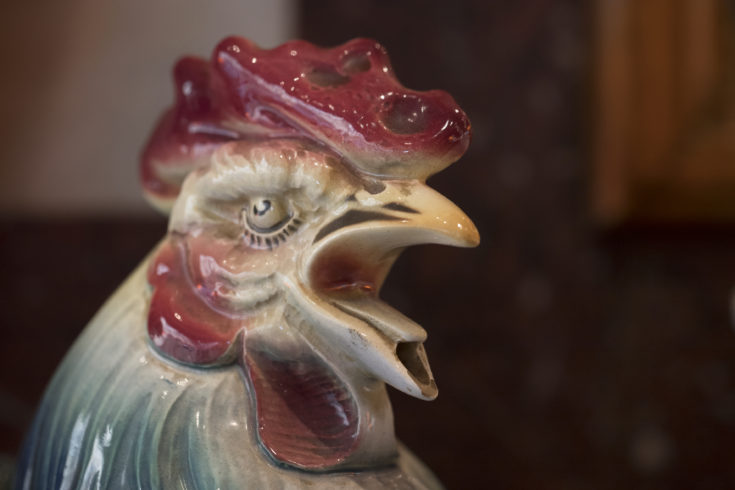
As someone who ardently loves good food, my goal here isn’t to open the back of the cyber business models that drive the internet, but to simply observe that they are changing the way we eat in ways which often reward good public relations more than they do good cooking. When it comes to Le Flaubert, I still remember the flutter this place caused when it first opened, because it was so surprising in 1987 that a Michelin two-star chef would turn his hand to affordable everyday dining. But insofar as this idiom is concerned, Michel Rostang is every bit as much a father of “La Bistronomie,” or modern French bistro cooking, as chef Christian Constant and the band of young chefs he trained, notably Yves Camdeborde, Eric Frechon and Thierry Breton.
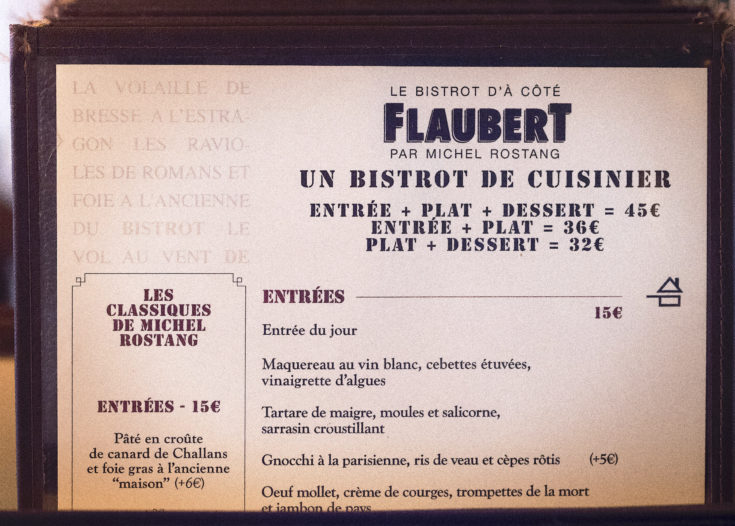
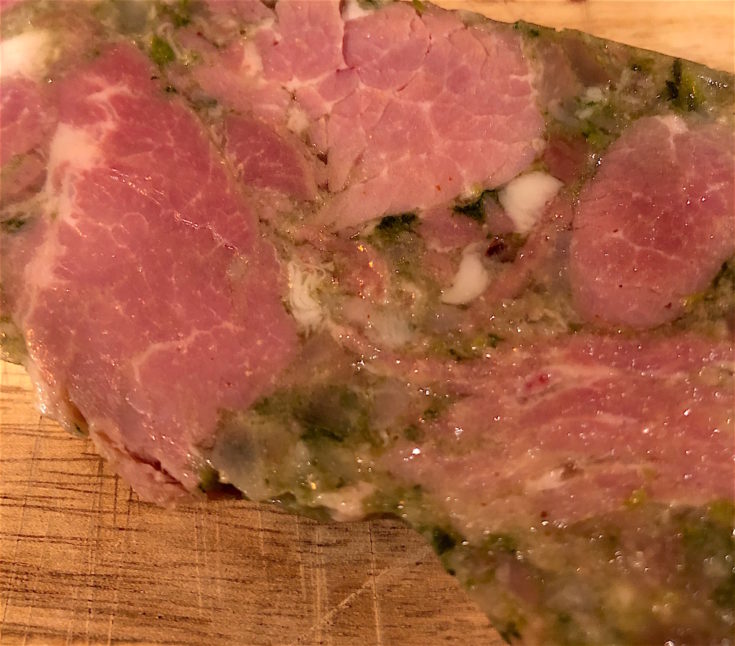
After the meal I had here the other night, I can also say that this table is not only better than ever but has become one of the finest bistros in Paris. So what lucky happenstance it was that delivered me to its door, and my thanks to my Capetonian friends for getting me back here. As soon as we stepped through the door, the atmosphere was terrific–the dining room had that wonderful winter fug generated by people who are eating and drinking well, and the hostess here, Laetitia, was delightful from the moment she brought us our menus with that sort of saucy, bemusedly wry social posturing that’s bistro service at its best. We ordered glasses of Condrieu, because who wouldn’t, and after they came to the table Laetitia followed with a slice of excellent homemade jambon persille (a Burgundian terrine of chunks of ham in parsley-brightened aspic).
The South Africans were as excited as baby seals to be in Paris again after a very longtime, and since neither of them speak French, I sherpa-ed them through the menu, which left them squirming in their seats with anticipation. And since even after many years as a Parisian, I could never become blasé about the city myself, we were an eager audience when our starters arrived.
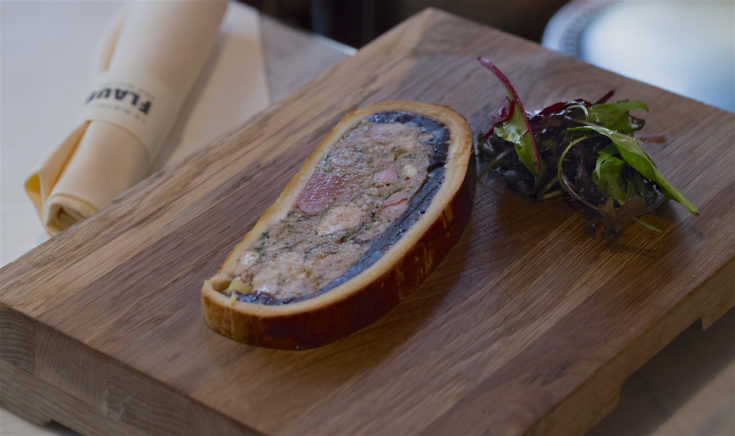
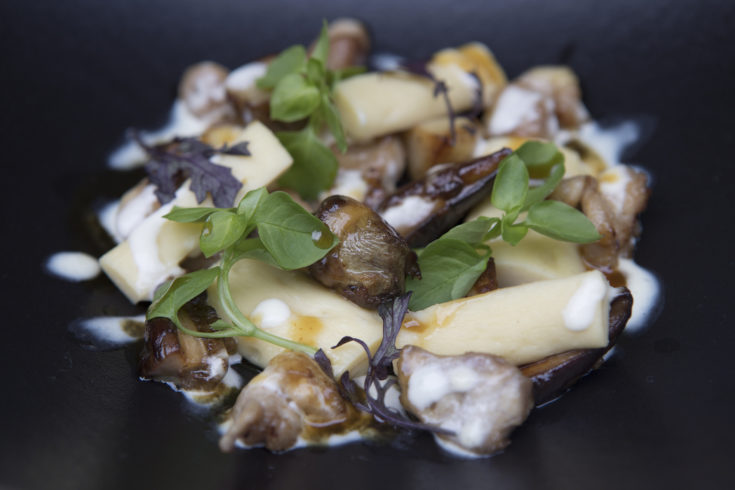
Caroline’s mackerel poached in white wine was beautifully plated with pickled vegetables and poached spring onions with an iodine rich seaweed vinaigrette, while Hunter slipped into sort of a monastic meditative bliss as he ate his duck and foie gras pate en croute, which was encased first in buttery pastry and then in a shimmering garter of dark amber aspic–I forked in here, and it was in a mouthful everything that has always defined this restaurant, or a sort of exalted rusticity produced by applying steely haute-cuisine technique to bistro dishes. Much as I adore these friends, it was a struggle against a surge of animal avarice to allow my friends to taste my airy gnocchi a la Parisienne with roasted ceps and sweetbreads, since this was not only one of the best dishes I’ve eaten all year, it was ecstatically consoling on a cold, damp winter night. That said, I hate to think of how I might of reacted if either of them had asked for a second taste.
Our food was so soothing that it allowed us to unload our respective burdens–them, the corruption of the Zuma government, me–well, just guess, without denting our pleasure and move on to happier subjects of conversation, like the beach house that Hunter had designed for them on a pristine stretch of the Indian ocean in Mozambique, one of the most beautiful countries I’ve ever visited, or the intriguing way that Cape Town is slowly but surely recovering its essential DNA as a city once known as “The Tavern of the Seas.” To wit, they said that there’s more racial comity than ever there, and that it’s less and less self-conscious. Caroline asked me about “the handsome Macron” and all of us confessed that we didn’t have a clue as to what Bitcoin might be and couldn’t care less one way or another. We also chatted about the impact of the internet on our lives, the ways we love it, the ways we don’t, with Hunter expressing exasperation that anyone could become famous just for knowing how to grab our increasingly shattered attention spans in cyber space, as opposed to having some real talent.
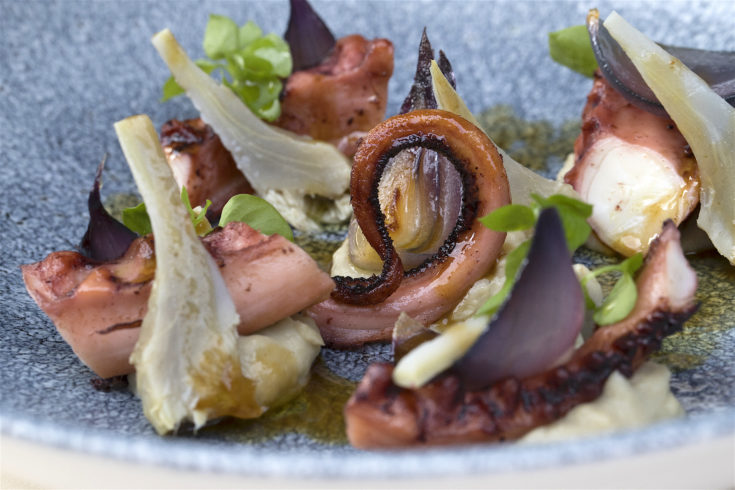
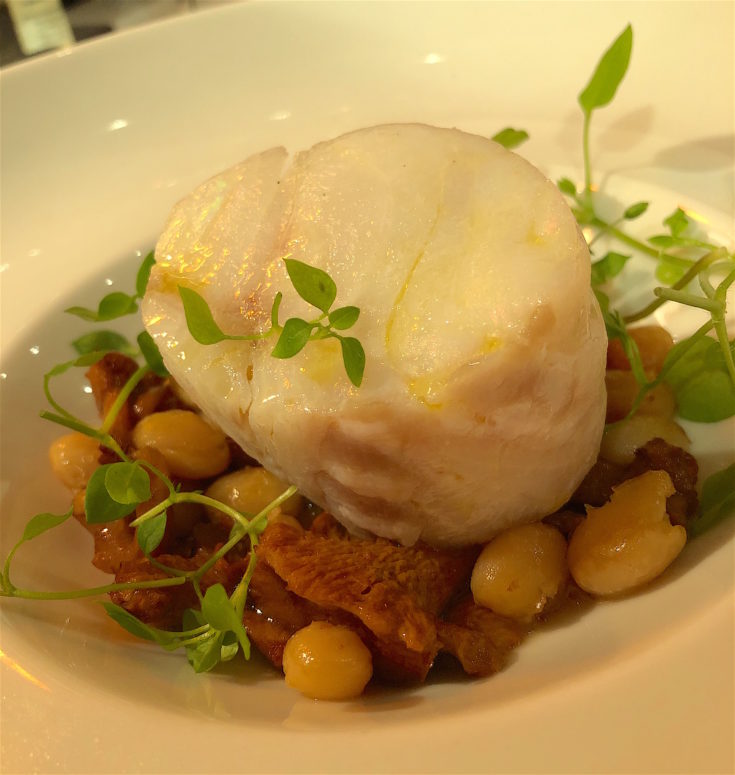
For mains, Caroline ordered the roasted octopus with artichoke and onions, because, as she later admitted, she’d never eaten octopus before (“it’s odd, but delicious,” was here take on this tentacled treat), and I couldn’t resist the olive-oil poached cod on a bed of Paimpol beans and ceps. Both dishes were made with superb produce, impeccably cooked and deeply satisfying, which put them at a notable difference from a lot of the wearisomely chef ‘bistronomique’ I’ve been eating too often lately.
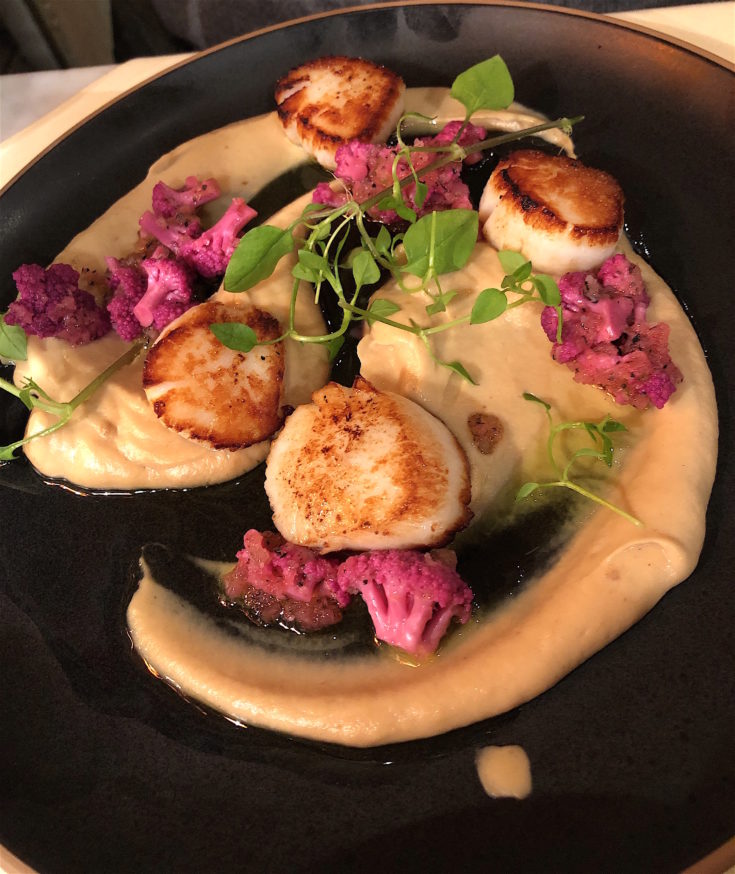
Hunter went with the daily special, seared scallops with parsnip puree and pickled cauliflower. “It’s rare to find fresh scallops in South Africa, and if you do, they’re no where near as good as these–so firm and such a nice gentle sweet taste,” he said in praise of these succulent marine morsels from Normandy.
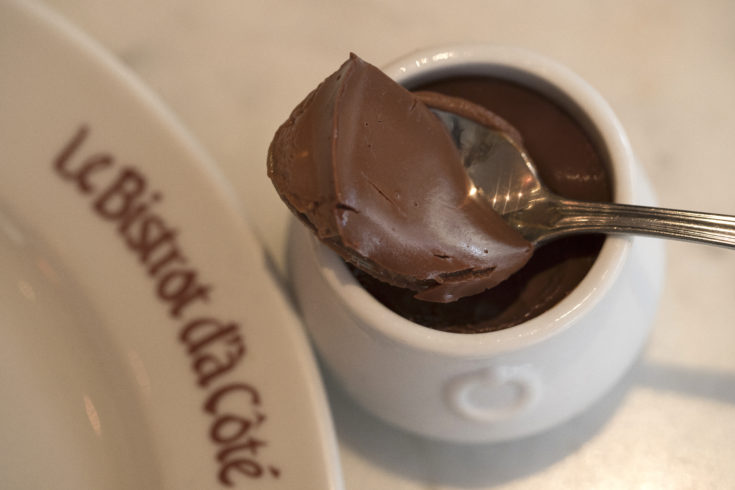
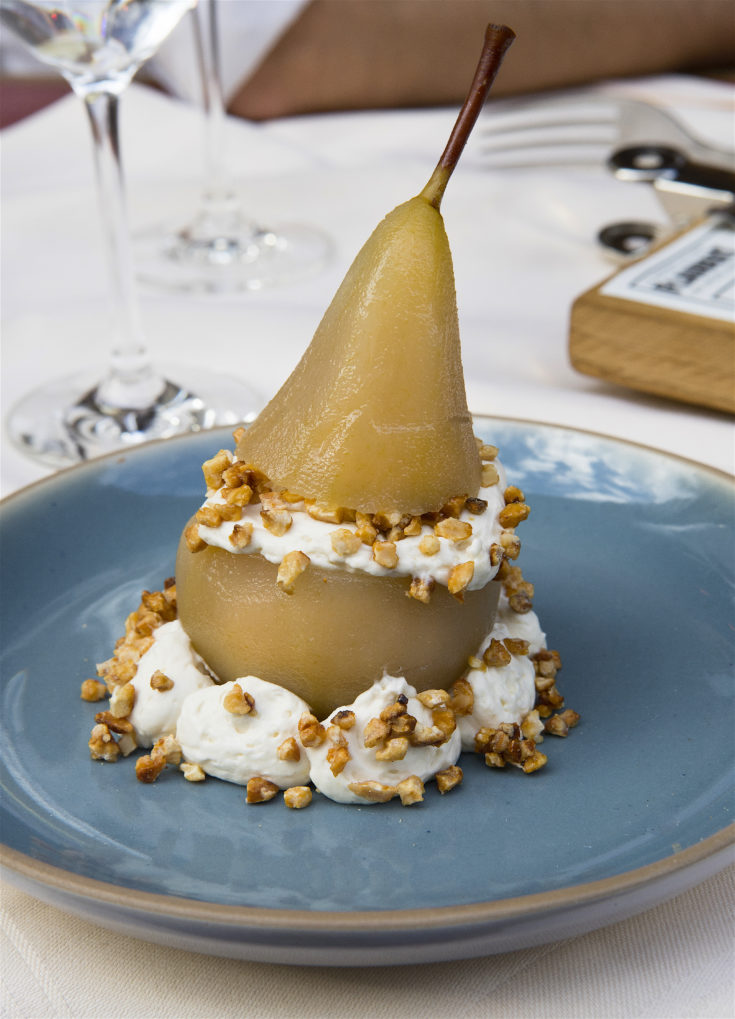
As part of a losing, but hopefully not futile, battle not to become a client of a chain of stores called the Big & Tall Men’s Store, a plus-sized place where I once worked as a college student for a few weeks one summer–my father insisted I get a job before I went away to my ‘real’ summer job as a waiter on Nantucket, because he didn’t want me “loafing around,” I don’t normally eat dessert. Still the South Africans insisted, so I told them about the first day on the job at the Big & Tall Men’s Store, the only store in a suburban Connecticut strip mall without a front door–the clients parked in back and came in through the back door, presumably because they were too embarrassed to be seen going into such a place, and I was astonished to discover box shorts the size of small circus tents and suits that would fit a redwood.
During the dull hours when there were no customers, I’d sit on a stool by the cash register reading, and then when the door bell rang, signaling the arrival of a client, I never knew what shape of misery I’d find when I looked up, often way up, or wide, often very wide. These men were hurried, furtive shoppers, because they were miserable being in the store and just wanted to get it over with in a hurry. I’d mostly leave them alone, since I knew they wanted as little interaction as possible, but occasionally I’d try to help, especially during the summer, when I’d ask them if they needed a bathing suit, too. Nine out of ten of them were hugely relieved by the suggestion. “Do you sell them?” “Yes” “In my size?” “Of course,” I’d say, and steer them away from the tropical prints and stripes to the solid colors.
My memory shared as a protest got me no where, though. “Well, you have thickened up a bit since we last saw you (note to self: never be coy about your weight), but that’s no reason not to have dessert with two dear friends,” said Caroline. So I ordered some honey ice cream with roasted prunes and raisins, because it sounded more healthy than anything else. Hunter went with the petits pots de creme au chocolat a l’ancienne (the world’s best chocolate custard) and Caroline, the poached pear with whipped cream and walnuts. And so there was a sweet ending for all of us to a wonderful reunion and an excellent meal.
Le Flaubert – Bistrot d’a Cote, 10 rue Gustave Flaubert, 17th Arrondissement, Paris, Tel. (33) 01- 42-67-05-81, Metro: Pereire, Wagram or Ternes. Open Tuesday to Friday for lunch and dinner. Saturday dinner only. Closed Sunday and Monday. Prix-fixe menus 45 Euros, 36 Euros, 32 Euros, Average a la carte 50 Euros. www.bistrotflaubert.com
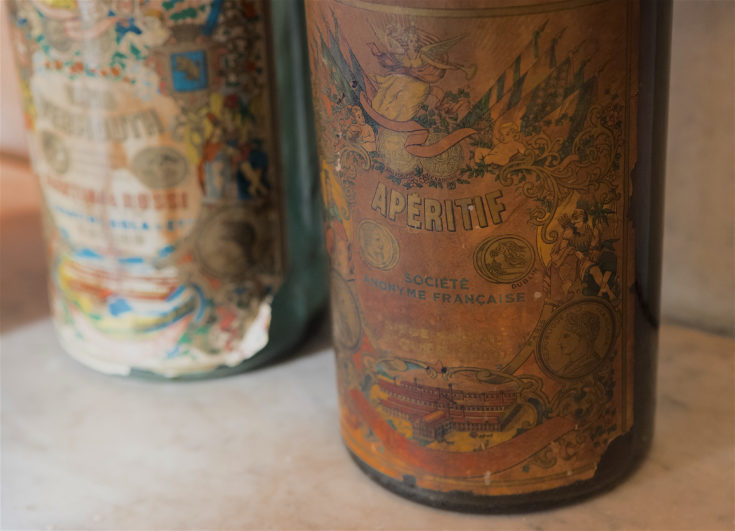















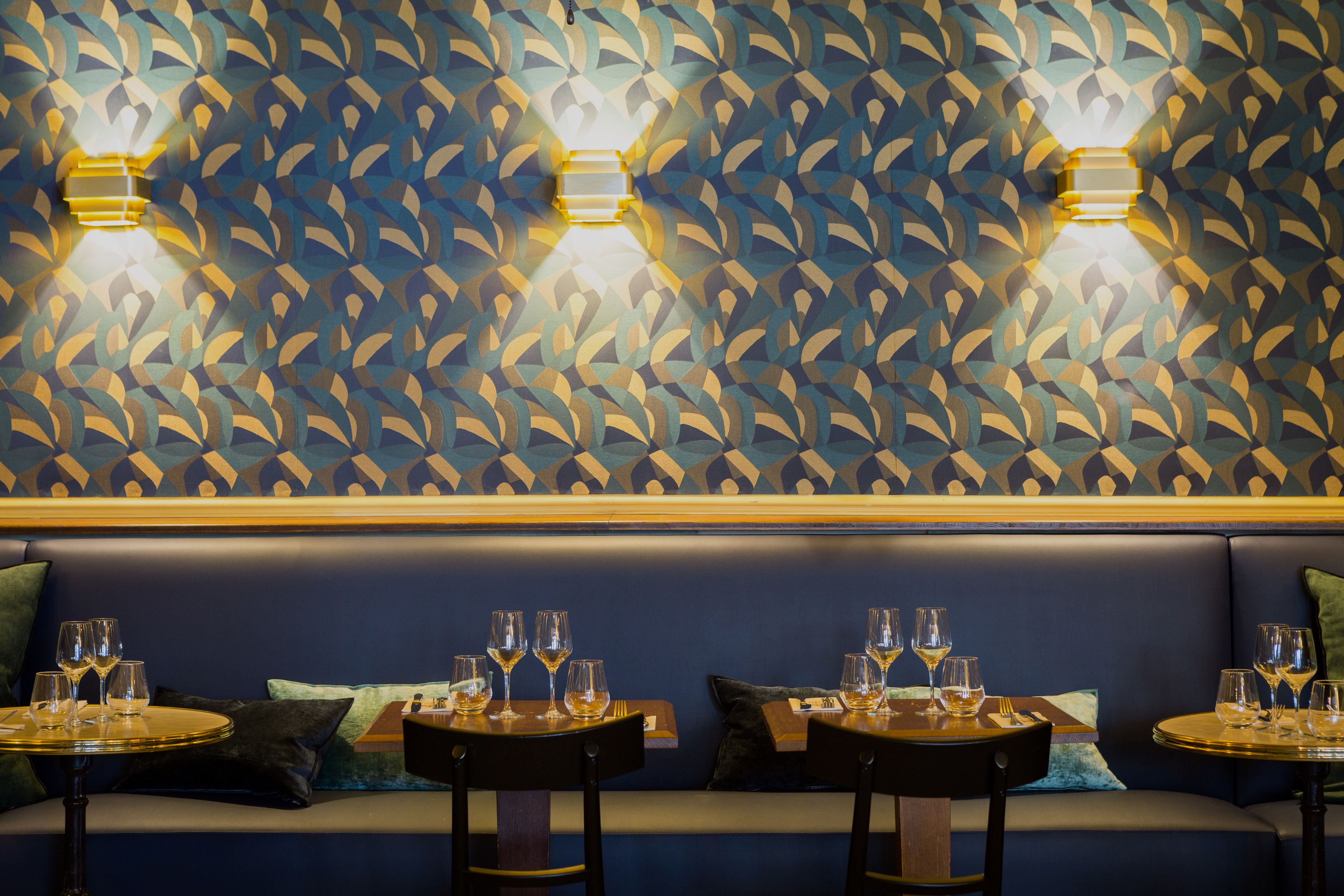
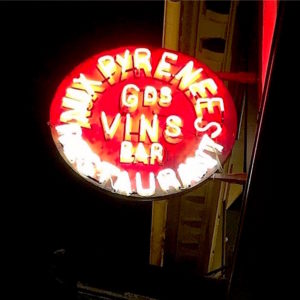 This is a rare good news story, too, at a time when income-inequality driven gentrification continues to ravage the sociological ecosystems of the world’s most desirable cities. Even though Paris is subject to the same forces have sadly dulled and pasteurised so many of the most wonderful parts of New York and London, and the French capital has been less disrupted than those latter two, the Marais continues to go relentlessly upmarket. But at Vins des Pyrénées, owner actor Florian Cadiou has shrewdly respected the enduringly democratic DNA of the quartier enough to draw up a menu that lets you pop in for a single course–maybe their excellent Croque Monsieur made with truffled Gouda, and a glass of wine for twenty euros, which is what goes a bargain these days in Paris.
This is a rare good news story, too, at a time when income-inequality driven gentrification continues to ravage the sociological ecosystems of the world’s most desirable cities. Even though Paris is subject to the same forces have sadly dulled and pasteurised so many of the most wonderful parts of New York and London, and the French capital has been less disrupted than those latter two, the Marais continues to go relentlessly upmarket. But at Vins des Pyrénées, owner actor Florian Cadiou has shrewdly respected the enduringly democratic DNA of the quartier enough to draw up a menu that lets you pop in for a single course–maybe their excellent Croque Monsieur made with truffled Gouda, and a glass of wine for twenty euros, which is what goes a bargain these days in Paris.